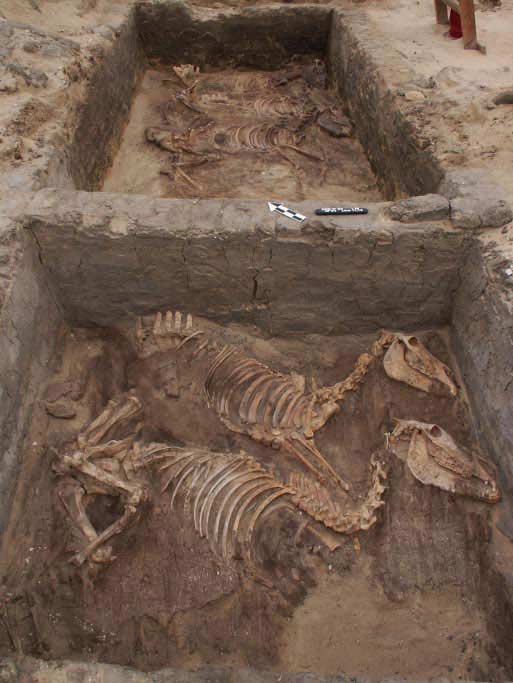Wild Ass Tamed, Buried with Egyptian King

One of the earliest Egyptian kings carried his "beasts of burden" into the afterlife. Paleoscientists discovered the skeletons of 10 donkeys nestled in three mud graves dating back 5,000 years ago when Egypt was just forming a state.
The donkey skeletons were discovered in 2003 lying on their sides in graves at a burial complex of one of the first pharaohs at Abydos, Egypt, which is about 300 miles (480 kilometers) south of Cairo. "There have been very few funerary complexes of the first pharaohs ever found," said Fiona Marshall, an anthropologist at Washington University in St. Louis, "and nobody expected that in some of the highest status graves there would be donkeys; you normally have high courtiers or nobles."
The excavators, who expected to at least find human remains and likely those of noble descent, got a surprise when they found grave areas full of donkeys. But only recently did scientists study the bones in detail to reveal the true significance of the discovery: The skeletons represent the first clear evidence of the domestication of the wild ass.
The new findings are reported online in the March 10 issue of the Proceedings of the National Academy of Sciences.
Dating donkeys
A donkey is a member of the Equidae family, which includes horses, zebras and African wild asses, which are the ancestors of domesticated donkeys. (A mule is the offspring of a male donkey, commonly called a jack ass, and a female horse, called a mare.)
Genetic studies and other research point to an African origin for donkeys about 6,000 years ago. The exact timing and location of the changeover from a wild meat source to a docile human helper have been tricky to pinpoint, however.
Sign up for the Live Science daily newsletter now
Get the world’s most fascinating discoveries delivered straight to your inbox.
For one, donkey skeletons from thousands of years ago are rare. In addition, researchers say it’s difficult to see changes that would distinguish wild from domesticated. Some past research of isolated donkey bones has relied on size as a marker of domestication. Smaller size was presumed to be associated with the crowded, hardworking conditions of domesticated versions compared with the free-foraging wild asses.
The date of burial is also a murky marker.
"Egyptian nobility hunted African wild ass long after donkeys were domesticated, so both occur on Dynastic Egyptian sites," Marshall and her colleagues write.
Some context
In the new study, whole skeletons allowed researchers to look at the bones in context to paint a picture of what the animals were up to so long ago.
Marshall and her colleagues compared the bones of the Abydos skeletons with 53 modern donkey and African wild ass skeletons. The results suggested the Abydos donkeys would have looked similar to the Somali wild ass, a subspecies of African wild ass that are still alive today. That would mean the Abydos donkey would have stood at four feet (1.2 meters) at the shoulder, weighing about 600 pounds (272 kilograms). For comparison, a zebra is about the same shoulder height and can weigh up to about 900 pounds (430 kilograms).
However, the wear and tear of joints and other boney characteristics indicated the animals carried heavy loads like modern-day donkeys. Every load-bearing joint of the donkeys showed signs of abrasion, suggesting so much wear and tear that the joints' protective tissue – the cartilage – had worn away. The researchers noted arthritis of the vertebra bones just behind the shoulders, where loads are typically placed. While they weren’t young’uns, the donkeys were not old enough to justify the bone damage, with the donkeys’ estimated ages somewhere between 8 and 13 years when they perished.
Noble ass
The donkeys as beasts of burden would have represented the earliest use of animals (other than humans) to carry humans and their goods.
“This is the first evidence for donkeys carrying loads, which is important because they were the first transport animal,” Marshall told LiveScience, “absolutely the first loads off humans' backs to create land transport routes, the earliest trade routes between Egyptians and Sumerians and so on.”
The importance of the donkey haulers is supported by the skeletons’ burial location. The researchers speculate the donkeys were associated with the tomb of either King Narmer or King Aha. King Narmer is known for unifying Upper and Lower Egypt and creating the world’s first nation-state.
“It certainly suggests they were of very great importance to the pharaoh and the early Egyptian state,” Marshall said. “It's very likely that having land-based transport of this kind actually helped to integrate the state, which was the world's first and earliest nation-state.”
- Gallery: Amazing Egyptian Discoveries
- Gallery: The World’s Biggest Beasts
- Top 10 Ancient Capitals
Jeanna Bryner is managing editor of Scientific American. Previously she was editor in chief of Live Science and, prior to that, an editor at Scholastic's Science World magazine. Bryner has an English degree from Salisbury University, a master's degree in biogeochemistry and environmental sciences from the University of Maryland and a graduate science journalism degree from New York University. She has worked as a biologist in Florida, where she monitored wetlands and did field surveys for endangered species, including the gorgeous Florida Scrub Jay. She also received an ocean sciences journalism fellowship from the Woods Hole Oceanographic Institution. She is a firm believer that science is for everyone and that just about everything can be viewed through the lens of science.









